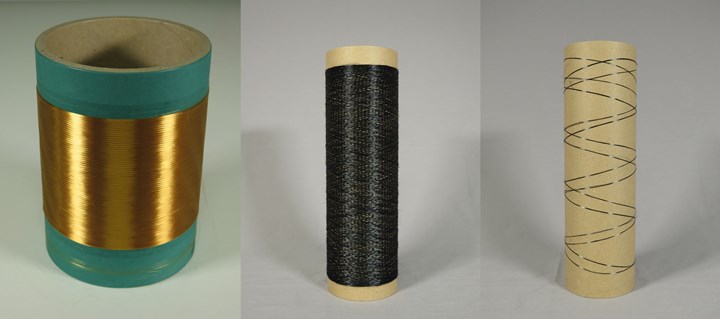DITF develops water-spun lignin fibers as PAN precursor alternative
Lignin fibers produced via an aqueous solution and dry spinning process result in homogeneous, smooth-surfaced fibers that are more environmentally friendly and cost-saving.
Water-spun lignin precursor fibers, stabilized and carbonized continuous filaments. Photo Credit: DITF
The German Institutes of Textile and Fiber Research (DITF, Denkendorf) has developed a novel process for the production of carbon fibers from lignin, which the institute says is environmentally friendly and cost-saving through the avoidance of solvents and the use of natural raw materials. The process is also characterized by high energy savings in all process steps of the carbon fiber production process.
Lignin, a rigid and woody polymer that is a key structural material for plants, replaces polyacrylonitrile (PAN) for the production of precursor fibers, which are converted into carbon fibers in a second process step. According to DITF, the raw material, a waste product in paper production, is inexpensive and available in large quantities.
The new process for producing lignin fibers is based on an aqueous solution of lignin, removing the requirement for solvents or toxic additives. For this purpose, wood is separated into its components, lignin and cellulose. A sulfite digestion process enables the production of lignosulfonate, which is dissolved in water. An aqueous solution of lignin is then the starting material for spinning the fibers.
The spinning process itself is carried out in a dry spinning process, where an extruder presses the spinning mass through a nozzle into a heated spinning shaft. The resulting continuous fibers are said to dry quickly and uniformly in the spinning shaft. Use of dry spinning, which enables high spinning speeds is said to produce more material in a shorter amount of time than what is possible with PAN fibers.
The following steps for the production of carbon fibers, namely stabilization in hot air and subsequent carbonization in a high-temperature furnace, are similar to those of the usual process when PAN is used as a precursor fiber, DITF notes. However, lignin fibers provide an advantage in that they can be stabilized particularly quickly in the oven with hot air and only require relatively low temperatures in carbonization. The energy savings in these process steps compared with PAN are said to be around 50%. The resulting fibers are homogeneous, have smooth surfaces and no adhesions, and have almost comparable mechanical properties to PAN-based carbon fibers, DITF says, in terms of strength, resistance and light weight.
The institute notes that carbon fibers made from these water-spun lignin fibers are likely to be of particular interest for applications in the construction and automotive sectors, which benefit greatly from cost reductions in the production process.
For related information about alternatives to PAN precursor, read more about bio-based acrylonitrile for carbon fiber manufacture, or a textile-based PAN tested in thermoplastic composite tapes.
Related Content
-
Manufacturing the MFFD thermoplastic composite fuselage
Demonstrator’s upper, lower shells and assembly prove materials and new processes for lighter, cheaper and more sustainable high-rate future aircraft.
-
Natural fiber composites: Growing to fit sustainability needs
Led by global and industry-wide sustainability goals, commercial interest in flax and hemp fiber-reinforced composites grows into higher-performance, higher-volume applications.
-
Cryo-compressed hydrogen, the best solution for storage and refueling stations?
Cryomotive’s CRYOGAS solution claims the highest storage density, lowest refueling cost and widest operating range without H2 losses while using one-fifth the carbon fiber required in compressed gas tanks.

















